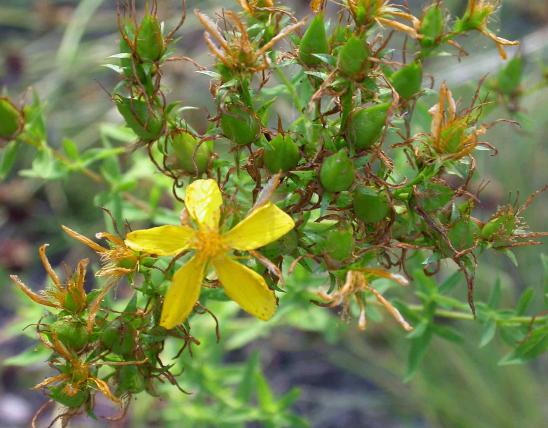
Shrubby St.John's-wort is a tall, densely branched shrub with sharply 2-edged twigs.
Flowers are in small groups (cymes), showy, 5-parted with abundant stamens, yellow. Blooms June–September.
Leaves are opposite, narrowly elliptical, abruptly narrowed toward base, to 2½ inches long, sessile, shiny, somewhat leathery.
Fruits are capsules about ¾ inch long, splitting at the tip, with numerous small seeds.
Similar species: There are 14 species of Hypericum in Missouri. They all have opposite, simple, entire leaves with small resin dots, and flowers with 4 or 5 yellow petals, 4 or 5 sepals, many stamens, and 1 pistil. Many are small shrubs, with twigs often angled or 2-winged. Fruits are capsules with numerous seeds. They bridge the gap between "woody" "nonwoody" plants, and many can easily be classified as "wildflowers," demonstrating that putting plants into these categories is less than satisfactory.
Height: to 6 feet.

Scattered nearly statewide. Apparently absent from the northwestern third of the state and from portions of the Mississippi Lowlands.
Habitat and Conservation
Occurs in dry or moist upland forests, margins of glades, banks and gravel bars of streams and rivers, ledges, tops, and bases of bluffs, and rarely bottomland forests; also fallow fields and old fields.
Human Connections
This shrub has showy flowers, tolerates dry rocky and sandy soils, and can be grown as a native ornamental hedge. It is also used to stabilize embankments. Plants in this genus have a long history of medicinal use and were burned in bonfires on St. John’s Eve (June 23) to ward off evil spirits.
Ecosystem Connections
Many insects visit the flowers, which offer only pollen, and not nectar (note the many pollen-bearing stamens). This is a larval host plant for the gray hairstreak butterfly, and several other insects also feed on the plant. The plant’s toxic chemicals prevent mammals from eating it.





























